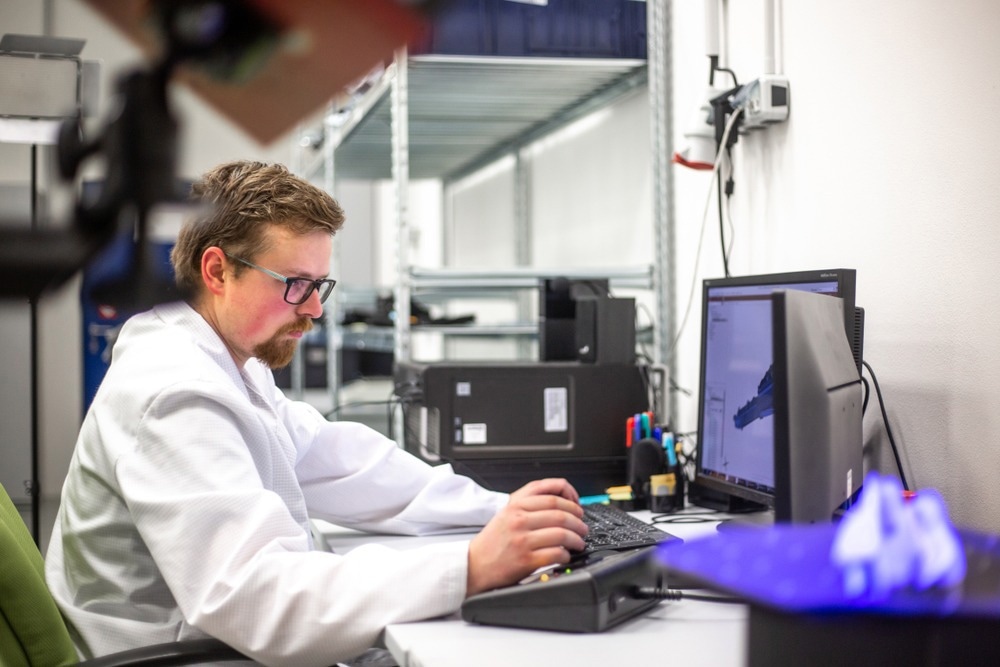A recent study published in Sensors demonstrates a novel 3D metrology method using a single camera and rotating anamorphic lens based on the properties of double optical centers for anamorphic imaging. The anamorphic images taken before and after the rotation of anamorphic lenses were used for the 3D reconstruction of the measured item. The anamorphic lenses were rotated 90° around their optical axis.

Study: 3D Metrology Using One Camera with Rotating Anamorphic Lenses. Image Credit: Simon Kadula/Shutterstock.com
Optical 3D Metrology Methods
3D metrology based on numerous techniques is a critical technology in modern industry.
The two types of 3D metrology are optical metrology and non-optical metrology. Non-optical techniques use scanning electron microscopes, coordinate measuring machines, and scanning probe microscopes for image processing.
Optical 3D metrology methods employ point autofocus instruments, chromatic confocal microscopy, imaging confocal microscopy, phase-shifting interferometry, focus variation instruments, coherence scanning interferometry, and stereo vision.
Optical 3D metrology techniques have unique characteristics and vary in effectiveness, measurement precision, scale, and cost. The methods used in optical metrology are frequently quick, accurate, and non-destructive. Optical 3D metrology techniques with two cameras with spherical lenses are often utilized.
The measuring precision of stereo vision ranges from several microns to millimeters, depending on the measurement area and the spherical lenses utilized. Extracting the corresponding points from stereo images is the most challenging task in stereo vision. Projectors are employed to produce structured light and produce high-quality matching dots.
Characteristics of Anamorphic Lenses
The film industry uses anamorphic lenses to produce prevalent images for wide screens. Anamorphic lenses comprise double optical centers and double focal lengths.
Double focal lengths refer to significant differences between the focal lengths in the tangential and sagittal planes. Anamorphic lenses are frequently utilized in the film industry because they enable horizontal image compression. Anamorphic lenses are also used in physics, some optical imaging applications, and metrology.
Double optical centers refer to two optical centers, one in the tangential plane and the other in the sagittal plane.
Anamorphic lenses separate the two optical centers by anamorphic distance. They are appropriate for 3D metrology as anamorphic distance provides anamorphic images with more 3D information.
Development of Novel 3D Metrology using Anamorphic Lenses
Chen et al. proposed a 3D metrology technique based on rotating anamorphic lenses and dual optical centers.
The two anamorphic images taken before and after the anamorphic rotation were used for 3D reconstruction of the data when the anamorphic lenses were rotated 90° around their optical axis.
Researchers presented both the anamorphic distortion model and the anamorphic imaging model. The 3D reconstruction method using spinning anamorphic lenses and the revolving anamorphic stereo vision were also described.
Anamorphic Imaging Model
Anamorphic lenses typically consist of an anamorphic attachment on the front and rear spherical lenses on the back. The cylindrical lenses that construct the anamorphic attachment have optical power in planes perpendicular to the cylinder axis but none in planes parallel to it. Anamorphic lenses' imaging model is distinct from the conventional pinhole imaging approach used for spherical lenses.
The anamorphic distance and angle are two intrinsic parameters of significant value in anamorphic lenses. The anamorphic distance determined by the cylindrical lenses or the anamorphic attachment must be adjusted accurately.
Research Findings
This study proposed the use of rotating anamorphic lenses for 3D metrology. The objects were captured in two anamorphic images before and after the lenses rotated by 90° along their optical axis.
Due to the setup's resemblance to stereo vision, it was categorized as stereo vision with anamorphic lenses.
Anamorphic lenses replaced spherical lenses in rotating anamorphic stereo vision. The baseline separation between the two anamorphic lenses was relatively small. These were the two fundamental differences between stereo vision and spinning anamorphic lenses.
Rotating anamorphic stereo vision had a lower measurement precision, particularly for the image points close to the axis of the anamorphic lenses compared to stereo vision. Rotating anamorphic stereo vision can be used for applications that require quick 3D reconstruction but low measurement accuracy, such as car navigation.
Future of Rotating Anamorphic Lenses in 3D Metrology
Rotating anamorphic lenses will become small sensors with capabilities suited for 3D metrology in confined spaces. The anamorphic distance, which would slightly alter the picture location of the object, is one internal characteristic of anamorphic lenses on which the viability of the suggested method for 3D reconstruction can be predicated.
High-precision anamorphic lens calibration, point matching for rotating anamorphic lenses, error correction, and huge anamorphic distance anamorphic lenses could all be the subject of future study.
Reference
Chen, X., Zhang, J., & Xi, J. (2022) 3D Metrology Using One Camera with Rotating Anamorphic Lenses. Sensors, 22(21), Article 21. https://www.mdpi.com/1424-8220/22/21/8407/htm
Disclaimer: The views expressed here are those of the author expressed in their private capacity and do not necessarily represent the views of AZoM.com Limited T/A AZoNetwork the owner and operator of this website. This disclaimer forms part of the Terms and conditions of use of this website.